

SoE%20Mtng%20PwrPt%2010.19.12%20(Finco) 20130406-112318.jpg (JPEG Image, 769 × 942 pixels) - Scaled (72%) Getting into the right mindset for better learning. Thanks to Educational Technology and Mobile Learning for drawing my attention to this infographic.
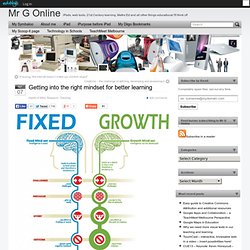
Learnng Styles take your test. Click here to take your learning styles test Information about learning styles and Multiple Intelligence (MI) is helpful for everyone especially for people with learning disabilities and Attention Deficit Disorder.

Knowing your learning style will help you develop coping strategies to compensate for your weaknesses and capitalize on your strengths. Paul Bailey: Twenty-Three Top Tips to Building Confidence. Get UK Lifestyle Newsletters: After coaching people for years on how to build confidence, I noticed a few of the same tips always seemed to come up trumps.

This is just a simple list of those ideas, rather than a full blown step by step guide. Some will resonate with you, others will seem rather old hat and tired, but the fact of the matter is that these really do work. If you do find one that particularly stands out for you, make a commitment to do something about it. As with all personal development or life goals in general, pick something that is new and previously untried. A simple list of ideas to help build your confidence:-
Thought stopping. Inventories/Questionnaires. Team Role Inventories. The Belbin Team Inventory is a personality test, also called the Belbin Self-Perception Inventory, Belbin Team Role Inventory, SPI or BTRSPI.
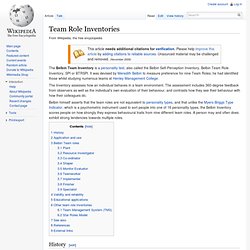
It was devised by Meredith Belbin to measure preference for nine Team Roles; he had identified those whilst studying numerous teams at Henley Management College. The Inventory assesses how an individual behaves in a team environment. The assessment includes 360-degree feedback from observers as well as the individual's own evaluation of their behaviour, and contrasts how they see their behaviour with how their colleagues do.
Ipsative. Ipsative (/ˈɪpsətɪv/; Latin: ipse, "of the self") is a descriptor used in psychology to indicate a specific type of measure in which respondents compare two or more desirable options and pick the one that is most preferred (sometimes called a "forced choice" scale).
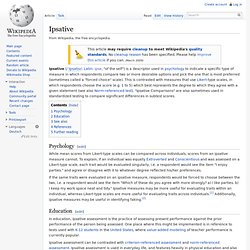
This is contrasted with measures that use Likert-type scales, in which respondents choose the score (e.g. 1 to 5) which best represents the degree to which they agree with a given statement (see also Norm-referenced test). "Ipsative Comparisons" are also sometimes used in standardized testing to compare significant differences in subtest scores. Myers-Briggs Type Indicator. Model of personality types A chart with descriptions of each Myers–Briggs personality type and the four dichotomies central to the theory The Myers–Briggs Type Indicator (MBTI) is an introspective self-report questionnaire indicating differing psychological preferences in how people perceive the world and make decisions.[1][2][3]

Myers briggs tf scale. Mental Toughness Development. Mental Toughness is a plastic personality trait which describes an individual’s mindset when faced with challenge, change and adversity.

Can it be developed? The answer is “it can” although that might happen in two ways and it won’t be immediately obvious which is happening. We can teach people of all ages to: Deal more effectively with stressors of all types – here we think we can make fundamental changes to the way a person thinks about problems and issues.Cope better with stressors – here we show an individual to adopt tactics and strategies which enable them to deal effectively with problems and issues. Mental Toughness Research Group. Emotional Intelligence - Daniel Goleman. In 1990, in my role as a science reporter at The New York Times, I chanced upon an article in a small academic journal by two psychologists, John Mayer, now at the University of New Hampshire, and Yale’s Peter Salovey.
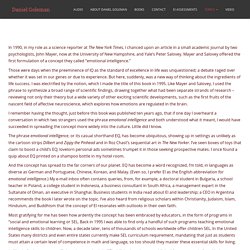
Mayer and Salovey offered the first formulation of a concept they called “emotional intelligence.” Those were days when the preeminence of IQ as the standard of excellence in life was unquestioned; a debate raged over whether it was set in our genes or due to experience. But here, suddenly, was a new way of thinking about the ingredients of life success. I was electrified by the notion, which I made the title of this book in 1995. I remember having the thought, just before this book was published ten years ago, that if one day I overheard a conversation in which two strangers used the phrase emotional intelligence and both understood what it meant, I would have succeeded in spreading the concept more widely into the culture. Warren G. Bennis Quotes. Warren Bennis. Warren Gamaliel Bennis (born March 8, 1925) is an American scholar, organizational consultant and author, widely regarded as a pioneer of the contemporary field of Leadership studies.[1] [2] Bennis is University Professor and Distinguished Professor of Business Administration and Founding Chairman of The Leadership Institute at the University of Southern California.[3] "His work at MIT in the 1960s on group behavior foreshadowed -- and helped bring about -- today's headlong plunge into less hierarchical, more democratic and adaptive institutions, private and public," management expert Tom Peters wrote in 1993 in the foreword to Bennis’ An Invented Life: Reflections on Leadership and Change.[1] Management expert James O'Toole, in a 2005 issue of Compass, published by Harvard University's John F.
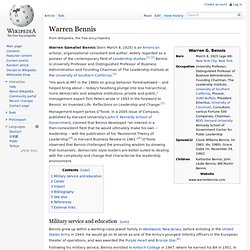
Military service and education[edit] Big Hairy Audacious Goal. A Big Hairy Audacious Goal (BHAG) is a strategic business statement similar to a vision statement which is created to focus an organization on a single medium-long term organization-wide goal which is audacious, likely to be externally questionable, but not internally regarded as impossible.
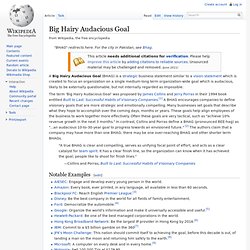
The term 'Big Hairy Audacious Goal' was proposed by James Collins and Jerry Porras in their 1994 book entitled Built to Last: Successful Habits of Visionary Companies.[1] A BHAG encourages companies to define visionary goals that are more strategic and emotionally compelling. Many businesses set goals that describe what they hope to accomplish over the coming days, months or years. These goals help align employees of the business to work together more effectively. Often these goals are very tactical, such as "achieve 10% revenue growth in the next 3 months. " Summary of Bounce – The science of success by Matthew Syed (Summarised by Paul Arnold – Trainer & Facilitator – paul_arnold) Bounce – The science of success. Matthew syed bounce quotes.
Matthew syed bounce. Home « Matthew Syed. Matthew Syed. Matthew Syed (born 2 November 1970) is a British journalist and broadcaster. He used to be an English table tennis international, and was the English number one for many years. He was three times the Men's Singles Champion at the Commonwealth Table Tennis Championships (in 1997, 2000 and 2001),[1] and also competed for Great Britain in two Olympic Games.[2] Life and career[edit] Learned helplessness. Psychological behavior Learned helplessness is behavior exhibited by a subject after enduring repeated aversive stimuli beyond their control. It was initially thought to be caused from the subject's acceptance of their powerlessness: discontinuing attempts to escape or avoid the aversive stimulus, even when such alternatives are unambiguously presented.
Upon exhibiting such behavior, the subject was said to have acquired learned helplessness.[1][2] Over the past few decades, neuroscience has provided insight into learned helplessness and shown that the original theory actually had it backwards: the brain's default state is to assume that control is not present, and the presence of "helpfulness" is what actually learned first. However, it is unlearned when facing with prolonged aversive stimulation.[3] In humans, learned helplessness is related to the concept of self-efficacy; the individual's belief in their innate ability to achieve goals. Martin Seligman. Martin E. P. "Marty" Seligman (born August 12, 1942) is an American psychologist, educator, and author of self-help books. His theory of learned helplessness is popular among scientific and clinical psychologists.[1] According to Haggbloom et al.'s study of the most eminent psychologists of the 20th century, Seligman was the 13th most frequently cited psychologist in introductory psychology textbooks throughout the century, as well as the 31st most eminent overall.[2] Seligman has written about positive psychology topics such as The Optimistic Child, Child's Play, Learned Optimism, Authentic Happiness, and Flourish.
Motivate Yourself - 8 Top Coaches Offer Advice. Thinking, Fast and Slow by Daniel Kahneman – review. A human being "is a dark and veiled thing; and whereas the hare has seven skins, the human being can shed seven times seventy skins and still not be able to say: This is really you, this is no longer outer shell. " So said Nietzsche, and Freud agreed: we are ignorant of ourselves. The idea surged in the 20th century and became a commonplace, a "whole climate of opinion", in Auden's phrase. It's still a commonplace, but it's changing shape. Thinking, Fast and Slow. What is Mindset. Every so often a truly groundbreaking idea comes along. Mindset (book) Authentic Leadership. Think three positives.
Does confidence really breed success? 3 January 2013Last updated at 19:32 ET By William Kremer BBC World Service. Generation Y. Volatility, uncertainty, complexity and ambiguity. Jim%20Collins,%20Good_to_Great_Summary_Principles%5B1%5D. GoodtoGreat. Good to Great. The book was a massive bestseller, selling four million copies and going far beyond the traditional audience of business books.[1] Writing[edit] Dan pink rsa animate drive. Shift happens 2013. The Real Game. Mental toughness. Imagine: How Creativity Works. Imagine: How Creativity Works is the third non-fiction book by Jonah Lehrer, published in 2012.
It explores brain science, and creativity and its social aspects.[1] By July 2012, the book had been recalled by its publisher due to factual inaccuracies.[2] Fabrication of Bob Dylan quotes[edit] In July 2012, Lehrer acknowledged that he fabricated some quotes attributed to Bob Dylan.[3] Sale of the electronic book as well as physical shipment of the book has been halted.[3] Imagine: How Creativity Works: Amazon.co.uk: Jonah Lehrer.